Noureddine Zerhouni
FEMTO-ST Institute, CNRS - UFC / ENSMM / UTBM, Automatic Control and Micro-Mechatronic Systems
Smart Data-Driven GRU Predictor for SnO$_2$ Thin films Characteristics
Sep 18, 2024



Abstract:In material physics, characterization techniques are foremost crucial for obtaining the materials data regarding the physical properties as well as structural, electronics, magnetic, optic, dielectric, and spectroscopic characteristics. However, for many materials, ensuring availability and safe accessibility is not always easy and fully warranted. Moreover, the use of modeling and simulation techniques need a lot of theoretical knowledge, in addition of being associated to costly computation time and a great complexity deal. Thus, analyzing materials with different techniques for multiple samples simultaneously, still be very challenging for engineers and researchers. It is worth noting that although of being very risky, X-ray diffraction is the well known and widely used characterization technique which gathers data from structural properties of crystalline 1d, 2d or 3d materials. We propose in this paper, a Smart GRU for Gated Recurrent Unit model to forcast structural characteristics or properties of thin films of tin oxide SnO$_2$(110). Indeed, thin films samples are elaborated and managed experimentally and the collected data dictionary is then used to generate an AI -- Artificial Intelligence -- GRU model for the thin films of tin oxide SnO$_2$(110) structural property characterization.
A deep learning pipeline for breast cancer ki-67 proliferation index scoring
Mar 14, 2022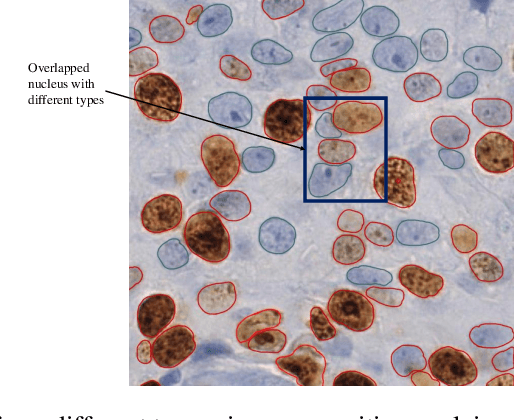

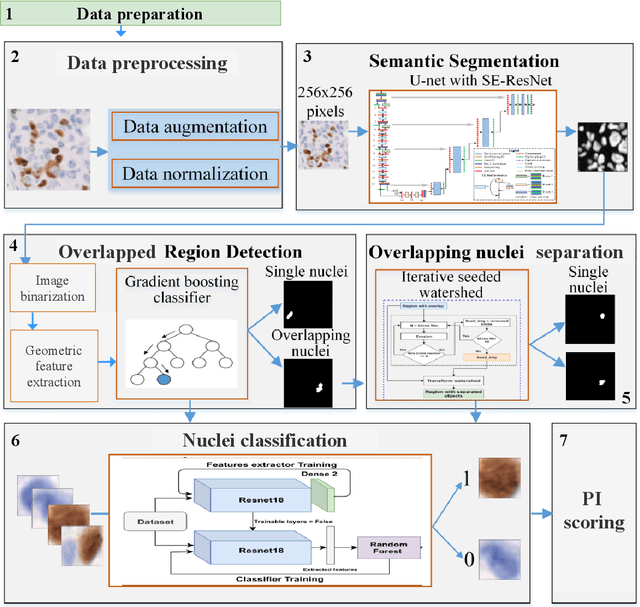

Abstract:The Ki-67 proliferation index is an essential biomarker that helps pathologists to diagnose and select appropriate treatments. However, automatic evaluation of Ki-67 is difficult due to nuclei overlapping and complex variations in their properties. This paper proposes an integrated pipeline for accurate automatic counting of Ki-67, where the impact of nuclei separation techniques is highlighted. First, semantic segmentation is performed by combining the Squeez and Excitation Resnet and Unet algorithms to extract nuclei from the background. The extracted nuclei are then divided into overlapped and non-overlapped regions based on eight geometric and statistical features. A marker-based Watershed algorithm is subsequently proposed and applied only to the overlapped regions to separate nuclei. Finally, deep features are extracted from each nucleus patch using Resnet18 and classified into positive or negative by a random forest classifier. The proposed pipeline's performance is validated on a dataset from the Department of Pathology at H\^opital Nord Franche-Comt\'e hospital.
Computer Aided Diagnosis for Spitzoid lesions classification using Artificial Intelligence techniques
Mar 10, 2020
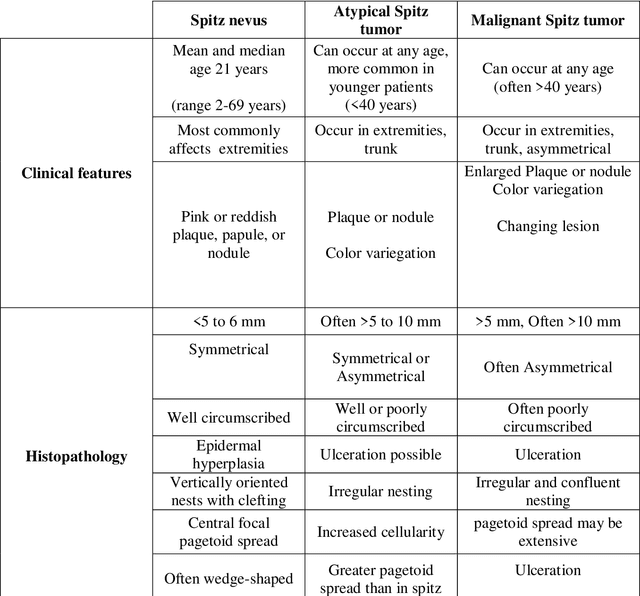


Abstract:Spitzoid lesions may be largely categorized into Spitz Nevus, Atypical Spitz Tumors, and Spitz Melanomas. Classifying a lesion precisely as Atypical Spitz Tumors or AST is challenging and often requires the integration of clinical, histological, and immunohistochemical features to differentiate AST from regular Spitz nevus and malignant Spitz melanomas. Specifically, this paper aims to test several artificial intelligence techniques so as to build a computer aided diagnosis system. A proposed three-phase approach is being implemented. In Phase I, collected data are preprocessed with an effective Synthetic Minority Oversampling TEchnique or SMOTE-based method being implemented to treat the imbalance data problem. Then, a feature selection mechanism using genetic algorithm (GA) is applied in Phase II. Finally, in Phase III, a ten-fold cross-validation method is used to compare the performance of seven machine-learning algorithms for classification. Results obtained with SMOTE-Multilayer Perceptron with GA-based 14 features show the highest classification accuracy (0.98), a sensitivity of 0.99, and a specificity of 0.98, outperforming other Spitzoid lesions classification algorithms.
A CNN-based methodology for breast cancer diagnosis using thermal images
Oct 30, 2019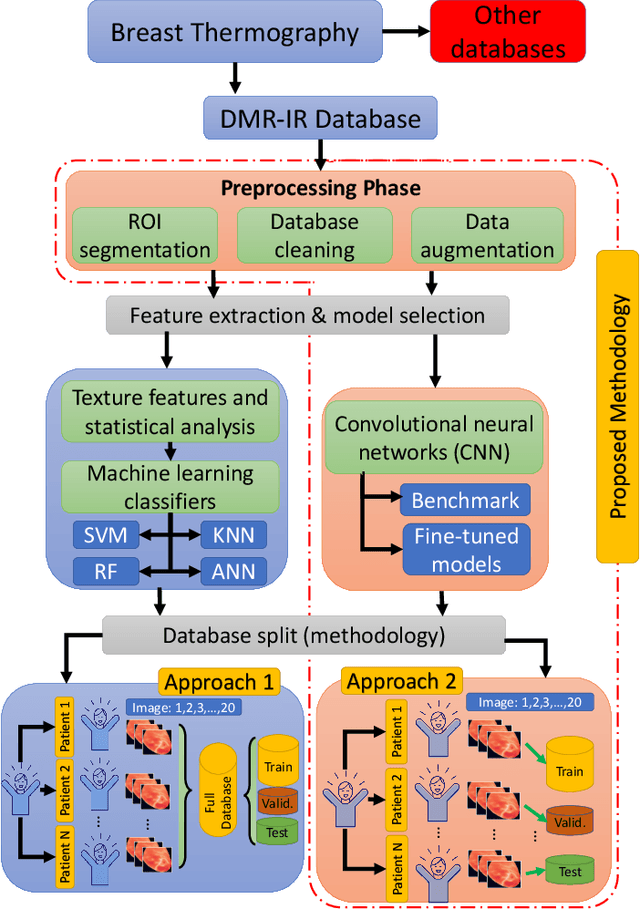
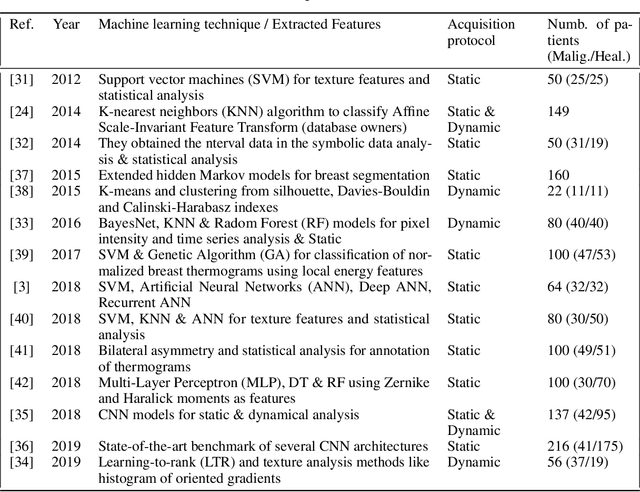
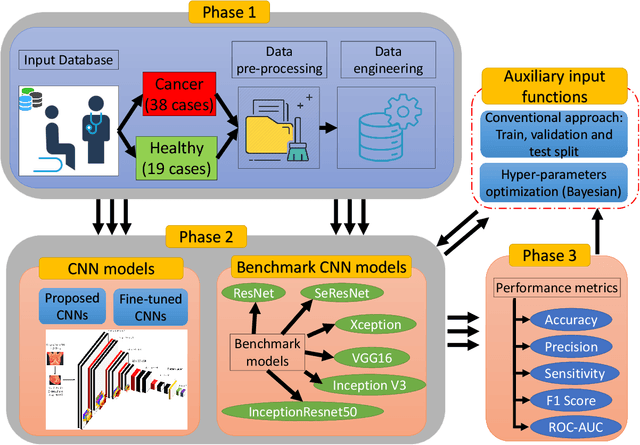
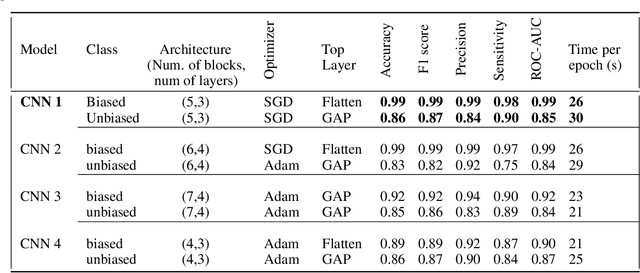
Abstract:Micro Abstract: A recent study from GLOBOCAN disclosed that during 2018 two million women worldwide had been diagnosed from breast cancer. This study presents a computer-aided diagnosis system based on convolutional neural networks as an alternative diagnosis methodology for breast cancer diagnosis with thermal images. Experimental results showed that lower false-positives and false-negatives classification rates are obtained when data pre-processing and data augmentation techniques are implemented in these thermal images. Background: There are many types of breast cancer screening techniques such as, mammography, magnetic resonance imaging, ultrasound and blood sample tests, which require either, expensive devices or personal qualified. Currently, some countries still lack access to these main screening techniques due to economic, social or cultural issues. The objective of this study is to demonstrate that computer-aided diagnosis(CAD) systems based on convolutional neural networks (CNN) are faster, reliable and robust than other techniques. Methods: We performed a study of the influence of data pre-processing, data augmentation and database size versus a proposed set of CNN models. Furthermore, we developed a CNN hyper-parameters fine-tuning optimization algorithm using a tree parzen estimator. Results: Among the 57 patients database, our CNN models obtained a higher accuracy (92\%) and F1-score (92\%) that outperforms several state-of-the-art architectures such as ResNet50, SeResNet50 and Inception. Also, we demonstrated that a CNN model that implements data-augmentation techniques reach identical performance metrics in comparison with a CNN that uses a database up to 50\% bigger. Conclusion: This study highlights the benefits of data augmentation and CNNs in thermal breast images. Also, it measures the influence of the database size in the performance of CNNs.
Post-prognostics decision in Cyber-Physical Systems
Oct 27, 2018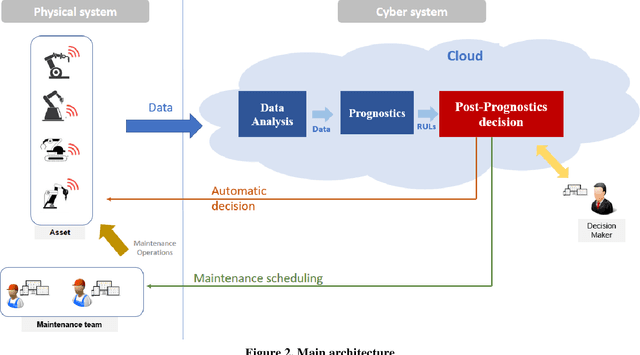
Abstract:Prognostics and Health Management (PHM) offers several benefits for predictive maintenance. It predicts the future behavior of a system as well as its Remaining Useful Life (RUL). This RUL is used to planned the maintenance operation to avoid the failure, the stop time and optimize the cost of the maintenance and failure. However, with the development of the industry the assets are nowadays distributed this is why the PHM needs to be developed using the new IT. In our work we propose a PHM solution based on Cyber physical system where the physical side is connected to the analyze process of the PHM which are developed in the cloud to be shared and to benefit of the cloud characteristics
 Add to Chrome
Add to Chrome Add to Firefox
Add to Firefox Add to Edge
Add to Edge